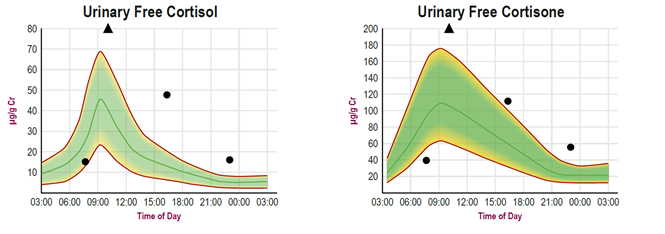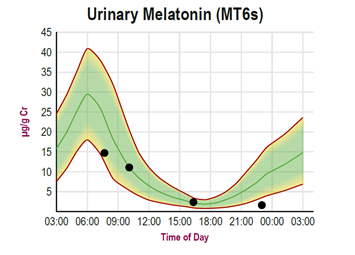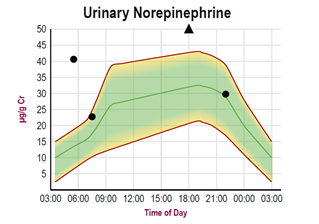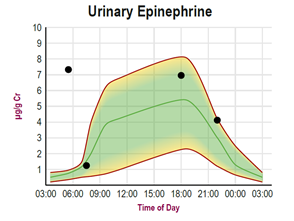
We are ancient biological beings living in a modern world where food and light are readily available all hours of the day and night; however, the daily pattern of light and dark that is the circadian rhythm still governs our behavior and physiology. “The circadian clock is an evolutionarily, highly conserved feature of most organisms. This internal timing mechanism coordinates biochemical, physiological and behavioral processes to maintain synchrony with the environmental cycles of light, temperature and nutrients” [1]. We are meant to be awake, active and consuming food during the daylight hours or the active phase of the circadian rhythm, and asleep when it is dark. Operating against our natural biological rhythms results in several chronic disease processes that undermine physical and mental health. Applying our knowledge of the circadian rhythm to how we live, eat and sleep, supports the foundations of optimal health and can serve as a backdrop to additional therapies providing a greater opportunity for successful outcomes.
The Purpose of the Circadian Rhythm
The circadian rhythm results from the synchronization of biological events with environmental cues and occurs in living organisms in an approximate 24-hour cycle. These rhythms are entrained by environmental stimuli referred to as “zeitgebers,” the German word for “time givers.” Zeitgebers can be photic, of or relating to light, or non-photic such as temperature, food, activity, exercise and social cues. As stated by Dr. Timothy Monk in the journal Sleep, “Circadian rhythms are driven by endogenous processes, are self-sustaining, and rely upon circadian time cues (zeitgebers) to remain appropriately oriented to the individual's environment and desired routine” [2]. He goes on to mention that behavioral circadian rhythms related to the timing of sleep, meals, work and social interactions also function as zeitgebers influencing our patterns of sleep and wakefulness.
The strongest zeitgeber that entrains the circadian rhythm is light. The cycles of light and dark that mark the passage of a single day signal the body’s internal clocks to perform specific functions in a timed and synchronized manner to optimize overall function. It is the internal clocks and clock genes that set the timing for these events and these timekeepers reside in almost all tissues and cells. The sequencing and timing of biological events supports energy efficiency within biological systems. If all necessary biological functions occurred at the same time, the efficiency of the system would break down. According to the musings of Albert Einstein, “The only reason for time is so that everything doesn’t happen at once.” Our circadian rhythm sets the timing for biological events so that everything doesn’t happen at once.
Recent Studies in Chronobiology
Chronobiology is the study of biological timing. Over the past decade, the field of chronobiology has rapidly expanded as researchers have begun unraveling the complex and integral role that the circadian clock plays in most physiological processes. Clocks, clock genes and clock proteins are inherent in all living organisms and provide a means of tracking and organizing biological events and behavior. In 2017, the Nobel Prize in Medicine or Physiology was awarded to Jeffrey C. Hall, PhD, Michael Rosbash, PhD and Michael W. Young, PhD who discovered the molecular mechanism that controls the circadian rhythm. Their studies revealed that the timing mechanism within each cell results in the creation and degradation of clock proteins in response to a negative feedback loop within a 24-hour period. This negative feedback loop was termed the Transcriptional Translational Feedback Loop (TTFL) and is responsible for the autonomous oscillator that occurs roughly every 24 hours in all cells [3].
Master Clock, Peripheral Clocks and Clock Genes
The endogenous mechanisms that regulate the circadian rhythm are organized in a hierarchical manner and consist of the master or central clock, the peripheral clocks and clock genes. The master clock is located in the suprachiasmatic nucleus (SCN) in the hypothalamus. Its location is directly above the optic chiasm and roughly 3 cm behind the eyes. The peripheral clocks are located in most tissues and organ systems and clock genes are located in every cell. While the master clock, in response to the 24-hour cycle of light and dark, sets the pacing for the peripheral clocks and clock genes, the internal oscillators of these clock mechanisms operate with some autonomy and can respond at the organ and cellular level to current metabolic events related to food consumption, sleep, and movement [4].
Light Signals and the Master Clock
The master clock in the SCN receives light signals from melanopsin, a light-sensing protein in the retina. This light signal is transferred via sympathetic neurons in the SCN to the paraventricular nucleus (PVN), the intermediolateral column (IML) to the superior cervical ganglia then to the pineal gland [1]. This light signal halts the production of melatonin by the pineal gland while stimulating epinephrine production by the adrenals via sympathetic signaling through the IML. The HPA axis along with the autonomic nervous system receive circadian signals and influence each other through neuronal signals and hormonal output. This network controls the circadian output of the adrenal glands in response to light and regulates sensitivity to ACTH and consequent hormone production. Cortisol and epinephrine act as synchronizers of the circadian rhythm with the peripheral clocks [4].
Cortisol as a Regulator of the Peripheral Clocks
Cortisol produced by the adrenal cortex can serve as a measure of a healthy circadian rhythm. According to an article in Endocrine Reviews, since the discovery of the 24-hour variation in glucocorticoid levels in humans, “an abundant literature has documented that the daily variation of circulating glucocorticoids is perhaps the largest and most robust circadian rhythm of all blood constituents in mammals” [5]. Cortisol and the autonomic nervous system act as a bridge between the master clock and the peripheral clocks. The daily fluctuation in cortisol levels and glucocorticoid receptor (GC) activation play an integral role in modulating endogenous and exogenous signals that direct biological activities confined to periods of light or darkness. However, when cortisol does not maintain a normal amplitude and pattern of output, the result is a flattened curve which could be either high or low in total cortisol output. When the cortisol amplitude and rhythmicity is flattened, the regulating influence on the circadian rhythm is impeded. The peaks and troughs of cortisol play a role in mitigating or enhancing the effects of clock genes on their target tissues while also integrating inter-organ signals with oscillations of the master clock to create a coordinated response. When those peaks and troughs are blunted, so is the signal that modulates the expression and activity of the clock genes [4].
Melatonin as the Signal for Darkness
As natural light dims in the evening, the signal to suppress melatonin decreases allowing melatonin to rise. Melatonin is often referred to as the molecular expression of darkness and its existence can be traced back to the origin of life. Melatonin is present in both plants and animals where its original purpose was that of free radical scavenger. The human body makes melatonin from the enzymatic conversion of serotonin to melatonin. Through receptor-mediated means, melatonin functions in the regulation of sleep and aging, modulation of circadian rhythms, enhancement of immunity, and as an oncostatic agent. Melatonin also maintains the ability to reduce oxidative stress by processes that are mostly receptor-independent [6]. Once melatonin is produced in the pineal gland in response to darkness, it is released into the bloodstream to bind to receptors in various tissues throughout the body enforcing circadian rhythms and supporting receptor-mediated functions.
Melatonin can also provide seasonal signals with higher levels in the fall and winter months and lower levels in the spring and summer correlating to the changing hours of daylight. Melatonin has two roles in the circadian rhythm. First, it entrains and shifts the circadian rhythm to align with the environmental cue of darkness. Secondly, it promotes sleep onset and continuity by increasing the drive to sleep and inducing a hypnotic state [7]. We can support our natural melatonin production by adhering to a normal sleep wake cycle and reducing our exposure to blue light as day turns to night. Robust melatonin production is also a mark of a healthy circadian rhythm.
The Chronic Stress Response
The chronic stress response occurs when the stressors that trigger the sympathetic nervous system and the HPA axis have an unrelenting nature. Inflammation, blood sugar imbalances, infections, lack of sleep and mental/emotional stressors can result in chronic stimulation of the stress response leading to a disrupted circadian rhythm. When the diurnal rhythm of cortisol is compromised and the necessary fluctuations in amplitude and rhythm are lost, the signaling message of cortisol to peripheral tissues and clock genes is blunted. Once the signaling message of cortisol is blunted, the timing of physiological events can be disrupted within tissues having GC receptors. Glucocorticoid receptors are widely distributed throughout the body, so the degree of physiological disruption may be extensive.
Measuring Markers of a Healthy Circadian Rhythm
Cortisol and melatonin have opposing rhythms and, when it comes to circadian timing, they are the main chemical mediators providing the signals that reset the peripheral clocks. Rising cortisol in the morning hours initiates the active phase and readies us for activity while melatonin initiates the inactive phase and increases the drive to sleep. Both cortisol and melatonin can be easily measured in body fluids to provide insight into the mechanisms that have an influence on the circadian rhythm. The Sleep Balance Profile from ZRT provides four dried urine measurements of cortisol, cortisone and the melatonin metabolite, MT6s (see example test report graphs below).


Add on options include a measurement of norepinephrine and epinephrine to assess the influence of the sympathetic nervous system.


This test can assess the patterns of cortisol and melatonin output and guide treatment considerations in normalizing the circadian rhythm.
In consideration of the metabolic and cardiovascular issues that can occur with circadian disruption, evaluating markers related to glucose management, lipids, inflammation and sex hormones can provide further insight and options for intervention. The ZRT Wellness Metrics Profile provides salivary sex hormones and four timed cortisol measurements along with blood spot measurements of TSH, D2, D3, Insulin and HbA1c. The ZRT Cardiometabolic Profile provides blood spot measurements of Insulin, hsCRP, HbA1c, TG, Total Cholesterol, HDL, LDL and VLDL.
Supporting a Healthy Circadian Rhythm
Rhythm disruptions can have wide-ranging effects on human health even after short-term circadian misalignment resulting in hypertension and elevated blood glucose and insulin levels. These are markers for metabolic and cardiovascular disease and translate to a higher incidence of obesity and type II diabetes [8]. We can have a positive influence on our circadian rhythm through the timing of our meals, sleep, activity and exercise.
Time-Restricted Eating - Eating is considered one of the non-photic zeitgebers that synchronizes the endogenous clock. The SCN has receptors for ghrelin, which stimulates hunger and receptors for leptin, which signals satiety. In studies using mice, increased exposure to light resulted in increased food intake which led to weight gain. Limiting food consumption to an 8-10 hour period and eating our final meal of the day 3-4 hours before bedtime supports the circadian influence on digestion, absorption and detoxification. Eating outside of regular mealtimes uncouples the peripheral clocks from the master clock and often results in weight gain particularly when large meals are consumed later in the evening [4].
Time-restricted eating allows the body to digest and absorb the nutrients from food when our body is most prepared to do so. Restricting food consumption to an 8-10 hour period reduces glucose and insulin levels and allows the body to tap into stored energy to support metabolic processes. Eating 2-3 three meals a day without snacking and within a time-restricted period trains the body to tap into stored energy and adipose as fuel rather than using readily available glucose from the most recent meal or snack.
Sleep - Sleep resets our physiological processes and allows the body to conserve energy, repair, rebuild and detoxify. Adhering to a regular sleep schedule that is aligned with our natural circadian rhythm supports these much-needed processes. During sleep, growth hormone increases to repair tissues while blood pressure, heart rate, body temperature, glucose and insulin decrease. We consolidate memories and dream during REM sleep while we deeply relax during quiet sleep. Supporting a healthy sleep cycle requires a bedtime somewhere between 9-10 pm preceded by a reduction in activity and reduced exposure to blue light. Sleeping in a cool room with the temperature between 60-65 degrees without ambient light supports melatonin output and deep, restorative sleep. If melatonin is determined to be low upon testing, melatonin supplementation 2-3 hours before intended bedtime can increase the drive to sleep. Elevated nighttime cortisol can be addressed through lifestyle measures, herbal adaptogens and phosphatidyl serine.
Activity and Exercise - As morning approaches, cortisol rises to its peak within 30 minutes of waking while melatonin continues to decrease upon exposure to light. Spending time in the bright morning sunlight can facilitate this shift. Daylight is considered the active phase in the circadian rhythm. Working in as much physical activity as possible supports sleep, blood sugar control and metabolic and cardiovascular health. Regular physical activity and exercise facilitates the non-photic entrainment of the circadian rhythm to external time cues. Exercising in the morning can increase metabolic rate throughout the day and increases cortisol output improving energy and focus. Intense exercise should be avoided later in the evening as it has the potential to increase cortisol and disrupt sleep.
Physical activity could fall under the category of activities of daily living that require us to be up and moving but are not necessarily increasing heart rate or muscle tension. Both types of movement should be included in the active phase of the circadian cycle. Those who have a more sedentary job or lifestyle would benefit from scheduling movement breaks at least every hour to incorporate activity or standing to offset the hours spent seated. Using devices to track steps throughout the day can provide data regarding actual activity and serve to motivate toward activity goals.
The Importance of a Healthy Circadian Rhythm
Honoring the natural patterns of light and dark, activity and sleep, food and fasting may seem overly simplistic. However, working with rather than against our biological rhythms can have a profound effect on our health as it is fundamental to who we are as humans and puts us back into the natural world of which we are a part. We have evolved as a species within these daily rhythms and our biology is calibrated to function accordingly. Making a few simple adjustments to synch our daily schedule with our natural rhythms can put us on track to better health. Measuring the key markers of cortisol and melatonin using the ZRT Sleep Balance Profile can provide more specific guidance in bringing our natural rhythms back into balance. Delving deeper into the issues of glucose management, insulin levels and metabolic and cardiovascular disease can start with a thorough evaluation using the ZRT Wellness Metrics Profile or the ZRT Cardiometabolic Profile.
Related Resources:
References
- Paul KN, et al. The Role of Retinal Photoreceptors in the Regulation of Circadian Rhythms. Rev Endocr Metab Disord. 2009;10:271–78.
- Monk TH. Enhancing Circadian Zeitgebers. Sleep. 2010;33:421–2.
- The Nobel Prize in Physiology or Medicine 2017. NobelPrize.Org.
- Minnetti M, et al. Fixing the Broken Clock in Adrenal Disorders: Focus on Glucocorticoids and Chronotherapy. J Endocrinol. 2020;246:R13–31.
- Oster H, et al. The Functional and Clinical Significance of the 24-Hour Rhythm of Circulating Glucocorticoids. Endocr Rev. 2017;38:3–45.
- Masters A, et al. Melatonin, the Hormone of Darkness: From Sleep Promotion to Ebola. Brain Disord Ther 2014;4:1000151.
- The Role of Melatonin in the Circadian Rhythm Sleep-Wake Cycle. Psychiatric Times.
- Koch CE, et al. Interaction between Circadian Rhythms and Stress. Neurobiol Stress 2017;6:57–67.
